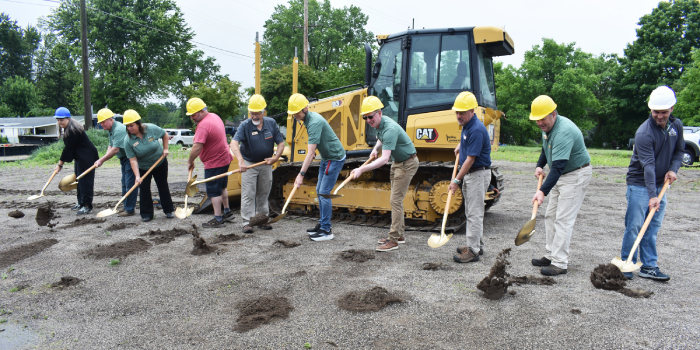Glacial stones help slow wave action and stabilize the shoreline at Pike Lake. Photo provided by The Watershed Foundation.
WARSAW — Shorelines at Warsaw’s Pike Lake and Kiwanis Park recently received major upgrades, thanks to a collaboration between The Watershed Foundation and the city of Warsaw.
“The primary problem was shoreline erosion at both locations,” said Brandon Cordell, MS4 coordinator for the city of Warsaw Stormwater Utility. Cordell explained that as a shoreline erodes, it undercuts vegetation and exposes tree roots, and sediment accumulates in the lake.
“We wanted to slow and stop that process,” he said. In addition, runoff from adjacent roads, parking lots, and lawns sends pollution into the lakes, and in areas where waterfowl tend to gather, their waste contributes to unhealthy levels of E. coli bacteria in water.
A crumbling cement seawall and eroding shoreline at Pike Lake before the restoration. Photo provided by the city of Warsaw.
“Erosion and runoff are significant threats to water quality in our local lakes,” agreed Lyn Crighton, TWF executive director. “Healthier shorelines lead to healthier lakes.”
At both sites, the solution was to restore and stabilize degraded stretches of shoreline with glacial stones, native plants, and other features. These updates are designed to protect water quality in Winona Lake and Pike Lake by reducing pollution from erosion, runoff, and other issues.
At Pike Lake, efforts focused on 200 feet of shoreline on the east side of the lake, adjacent to the Fireman’s Building and the campground boundary. A crumbling cement seawall was removed, and glacial stones were installed in its place to help slow wave action and stabilize the shoreline. These upgrades will improve water quality and help meet future plans for recreation at Pike Lake, a popular destination for swimming, boating, and other activities.
Kiwanis Park is located on a channel that feeds into the northwest side of Winona Lake. It serves as a public access site for boaters and is a popular spot for anglers. To protect against erosion there, glacial stones were installed along 256 feet of shoreline. In addition, turf grass was replaced with a diverse mix of native plant species, which will help capture runoff, filter pollution, and deter big groups of geese, who prefer open sightlines.
To enhance the park’s recreational appeal, dedicated stone fishing pads were also installed along the shoreline.
Work on both projects began late in 2024 and was completed this spring.
A deteriorating stretch of shoreline at Kiwanis Park before the restoration. Photo provided by the city of Warsaw
TWF and the city are planning educational signs for each location with information about how shoreline restoration promotes clean water and healthier lakes. The signs will be installed later in 2025.
Both projects were made possible through the combined efforts of multiple partners.
The Watershed Foundation provided grant funding for about 75% of the project costs. The city of Warsaw paid the other 25% of project costs with Stormwater Utility funds.
“TWF helped these projects come to fruition,” said Cordell. “Their grant saved us money, which lets us use our funds for greater impact to benefit the community of Warsaw.”
“We love to collaborate on solutions to pollution problems,” said Crighton. “TWF often works with private landowners, and those shoreline restoration projects take place on residential properties. This was an exciting opportunity to create healthier shorelines on public properties for the benefit of our community.”
The Stormwater Utility coordinated the overall planning, design, and execution of the shoreline restoration projects, with major support from the city of Warsaw’s Engineering Department. Other key partners included Warsaw Parks and Recreation and Wastewater Utility, G & G Hauling and Excavation, and engineering firm Stantec.
“Partnership makes (projects like these) a lot easier and more efficient,” said Cordell. “The more input and collaboration, the more successful we’re going to be. The ultimate goal is to protect the integrity of our water for future generations.”
To learn more about The Watershed Foundation’s Healthy Shorelines Initiative, including grant opportunities for shoreline restoration projects, visit
watershedfoundation.org/healthy-shorelines.
Glacial stones and native plants were installed at Kiwanis Park to create a healthier shoreline. Photo provided by The Watershed Foundation.






